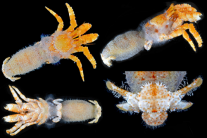On Friday, 18 October 2025 we hosted approximately 500 high school students at
It's a new crab species!
Thu, 01/21/2021 - 12:13pmDr. Darryl Felder of our biology department was searching for a mud lobster when he pulled a bag of crustaceans from his laboratory freezer in the University of Louisiana at Lafayette’s Billeaud Hall. He instead found a new species of hermit crab. “When I defrosted it, I thought, ‘My gosh, not only is that not a mud lobster, but that is a species that’s never been found before,’” the biologist said.
For five decades, the UL Lafayette professor emeritus of biology has researched decapods, which are 10-footed crustaceans that include lobsters, crabs, crawfish, prawns and shrimp. His research on the suspicious-looking mud lobster he’d chanced upon began simply. Felder compared his color photographs of the defrosted female specimen to others he had taken over the years of members of the hermit crab genus Cancellus. Subtle differences convinced him he was on the right track. Felder and a colleague, Dr. Rafael Lemaitre, began the process of verifying the new species, including exhaustive documentation and illustration of the inch-long hermit crabs’ anatomy. Lemaitre, an adjunct professor at UL Lafayette, is the curator of crustacea in the Smithsonian Institution’s Natural Museum of Natural History’s Department of Invertebrate Zoology.
The biologists eventually enlisted an alumna, Dr. Heather Bracken-Grissom, ’08, to provide a final piece of evidence – gene sequencing. She earned a Ph.D. from the University in environmental and evolutionary biology. Bracken-Grissom wasn’t aware examining DNA extracted from one of the crab’s legs wouldn’t be her only connection to the project. “When she sent the gene sequence back, I said, “By the way, surprise, this is your species,’” Felder said with a laugh. “I told her she bore her own cross, helping do some of the leg work to nail down identification of something that would be named for her.” Felder and Lemaitre named the crab Cancellus heatherae, or Heather crab, to acknowledge Bracken-Grissom’s “longstanding productivity and commitment to decapod crustacean research,” Felder said. Bracken-Grissom, an associate professor of biological sciences at Florida International University - Biscayne Bay Campus, was thrilled. She was quoted in an online article from that university recently. Bracken-Grissom said: “Long after I die, I’m going to be known in hermit crab form, which is awesome. Having a species named after you is the ultimate honor. To have it done by your role models, I can’t even describe how honored I feel.”
The findings, recently published in Zootaxa, put an exclamation point on a process that began in 2019 when the newly-identified hermit crab was dredged from a 300-foot deep reef in the northwestern Gulf of Mexico. It was hoisted aboard a 116-foot R/V Pelican, the Louisiana Universities Marine Consortium vessel outfitted for oceanic research. The crab was deposited among a heap of marine algae – rhodoliths and sea sponges – being scooped up for a study examining the health of the underwater ecosystem during an expedition funded by the National Science Foundation. A team of scientists led by UL Lafayette biology professor Dr. Suzanne Fredericq that was conducting research on the algae communities collected decapods that came up with the reef material as they went along. The Heather crab hit the deck minus its home – a hollowed out section of rhodolith, a calcified nodule resembling coral. That was a plus. The armorless hermit crab was originally mistaken, Felder said, for a member of “one of the lobster groups that I research. Were it not free of its typical enclosure, it is unlikely that anyone would have seen it and picked it up.”
Felder, who joined UL Lafayette in 1975, retired in 2014. He hasn’t quit working, though. Felder continues to conduct research. He described and named 16 new species – primarily small crabs – in 2020. “The room for additional work from now on is just incredible,” he added. Felder’s a big reason for that. He was a driving force responsible for the UL Lafayette Zoological Crustacean Collection – 18,000 jars containing 100,000 specimens of 2,000 species from the Caribbean Sea, the Atlantic and Pacific oceans and throughout the Gulf of Mexico. The collection, assembled over four decades by Felder, his colleagues, and student researchers, was acquired by the Smithsonian Institution’s National Museum of Natural History in 2018. It includes a comprehensive electronic database, research notes Felder made during expeditions, and more than 50,000 color photographs he took of specimens before they were preserved. The move means scientists from around the world now have access to what is likely the largest archive of gene sequence-quality marine decapod specimens from the Americas. That includes Felder, who holds an associate scientist position with the Smithsonian. “I plan to get up there often once COVID-19 restrictions that have closed the museum end. I have a bucket list of things to get done. What else could be more rewarding, you know? Science is wonderful in so many aspects. It keeps you entertained.”
Image caption: UL Lafayette researchers discovered a new species of hermit crab in Gulf of Mexico, Cancellus heatherae, or Heather crab. The specimen now belongs to a massive collection of 100,000 specimens of 2,000 species of decapod crustaceans that the Smithsonian Institution’s National Museum of Natural History acquired from the University in 2018. Image credit: Zootaxa, Magnolia Press

